-
Online reviews can boost your business’s credibility and improve local SEO, making it more visible on SERPs and driving more organic traffic.
-
The most popular review sites for local businesses include but are not limited to Google Business Profile, Facebook, Yelp, Foursquare, Trustpilot, Better Business Bureau, and more.
-
Directly asking customers for feedback through various channels like in-person interactions, follow-up messages, receipts, and post-purchase surveys can significantly increase the volume of reviews collected.
-
To encourage customer reviews, make the process as simple as possible. Include clear prompts and review widgets on your website. A dedicated review page can also help. Ensure the review process is smooth and user-friendly, especially on mobile devices.
-
Offering rewards, contests, or exclusive offers can incentivize customers to leave reviews.
-
Participating in local events and partnerships can organically generate positive word-of-mouth and reviews.
-
Respond promptly to both positive and negative reviews. Show appreciation for positive feedback and address negative reviews with empathy, apologies, and solutions to improve customer satisfaction.
Today, online reviews are the new word-of-mouth. Potential customers rely heavily on these testimonials to decide which products or services to opt for. Besides, many users use them for assessing a local business’s overall reputation and reliability.
In this article, we’ll explore the role of local business reviews and, what’s important, provide practical strategies to actively encourage and manage them. This should ultimately help you transform reviews into a powerful tool for building trust and driving business growth.
Disclaimer: This article was initially drafted using SE Ranking’s AI Writer. However, some parts of the text were written from scratch and the content has undergone thorough revisions, editing, and fact-checking by human editors and subject matter experts to ensure accuracy.
The importance of local business reviews
Online business reviews are more than just digital testimonials; they play a crucial role in reputation management by impacting credibility, showcasing genuine customer experiences, and guiding consumers’ purchase decisions.
Review signals significantly affect your local SEO. Search engines like Google prioritize businesses with recent and positive reviews, believing that these businesses provide better user experiences. Thus, the more favorable reviews you gather, the higher you rank in local searches, driving more organic traffic to your website.
Moreover, reviews are pivotal to consumer trust and reputation. An incredible 99.75% of online consumers report reading local reviews at least sometimes, and a substantial portion (91%) rely on them consistently. In turn, around 79% of people are influenced by online reviews when choosing a local business. Local business reviews are often compared to personal recommendations from those you know in real life.
Last but not least, reviews offer insights into what customers like and dislike about your business. You can use this information to improve products, services, and overall customer satisfaction.
Identifying key review sites & platforms
Choosing suitable platforms for customer reviews is like picking the right channels to communicate your brand’s story. While many review platforms exist on the market, some stand out for their reach and influence.
Google Business Profile
We strongly recommend starting with your Google Business Profile (GBP) optimization. The reason is simple: it is often the first touchpoint potential customers have with your business.
This is how optimized profiles look within Google Local Pack on SERPs:
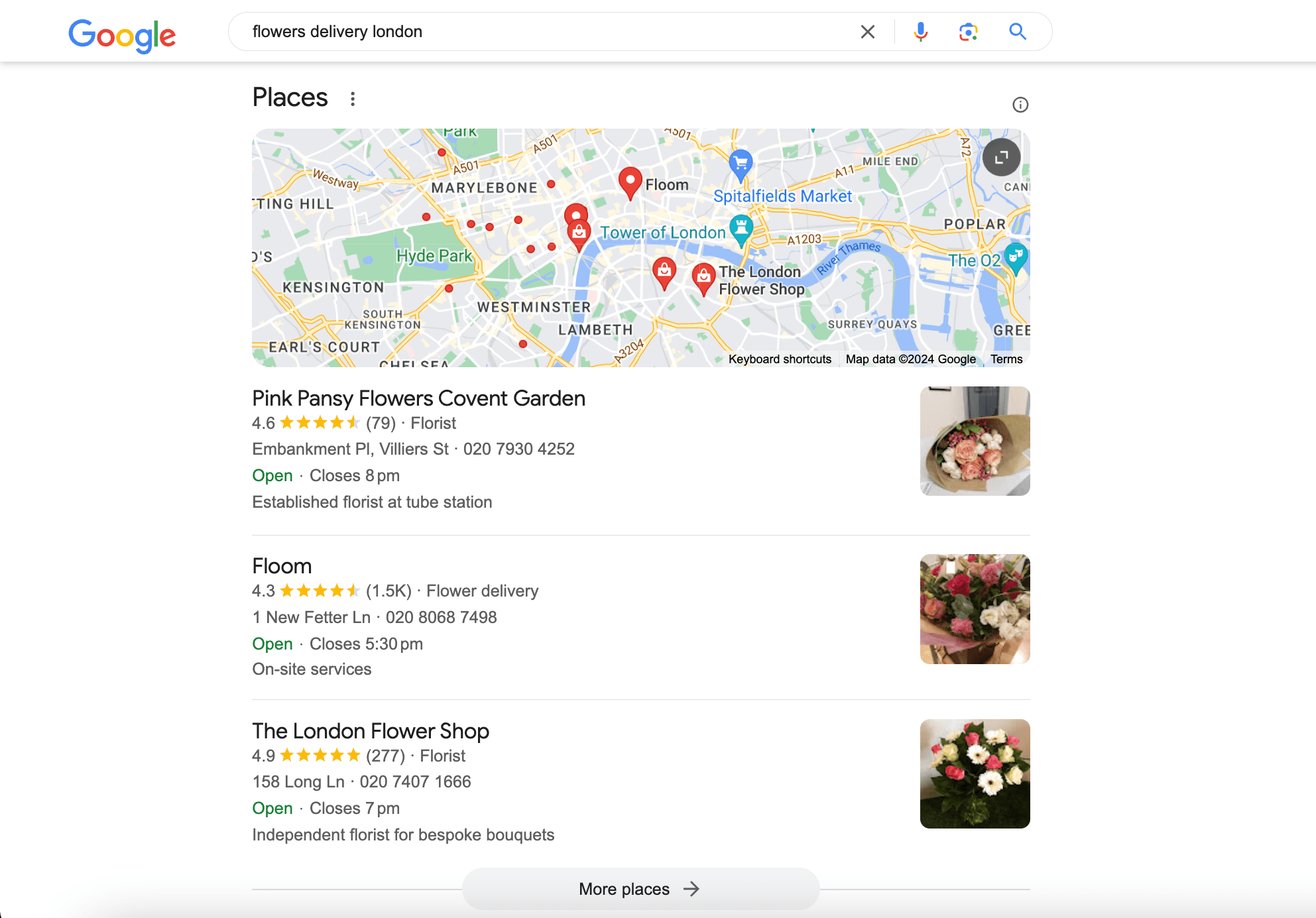
A well-optimized GBP enhances your visibility in local search results and on Google Maps, which makes it easier for customers to find and choose your business. Not to mention, potential customers can easily read your reviews right on Google Maps when they find your business. Your profile will also showcase popular phrases from your Google reviews.

Beyond search visibility, Google Business Profile offers valuable insights into consumer behavior. You can track website visits, phone calls, and direction requests. These analytics provide valuable data for refining your marketing strategies. It’s also a valuable tool for review management, which lets you engage with customers directly through the platform by responding to reviews and questions.
Facebook is another giant in the review ecosystem. With billions of users, it provides an additional layer of visibility and accessibility. Customers often feel comfortable leaving reviews here due to its familiar, social-friendly environment.
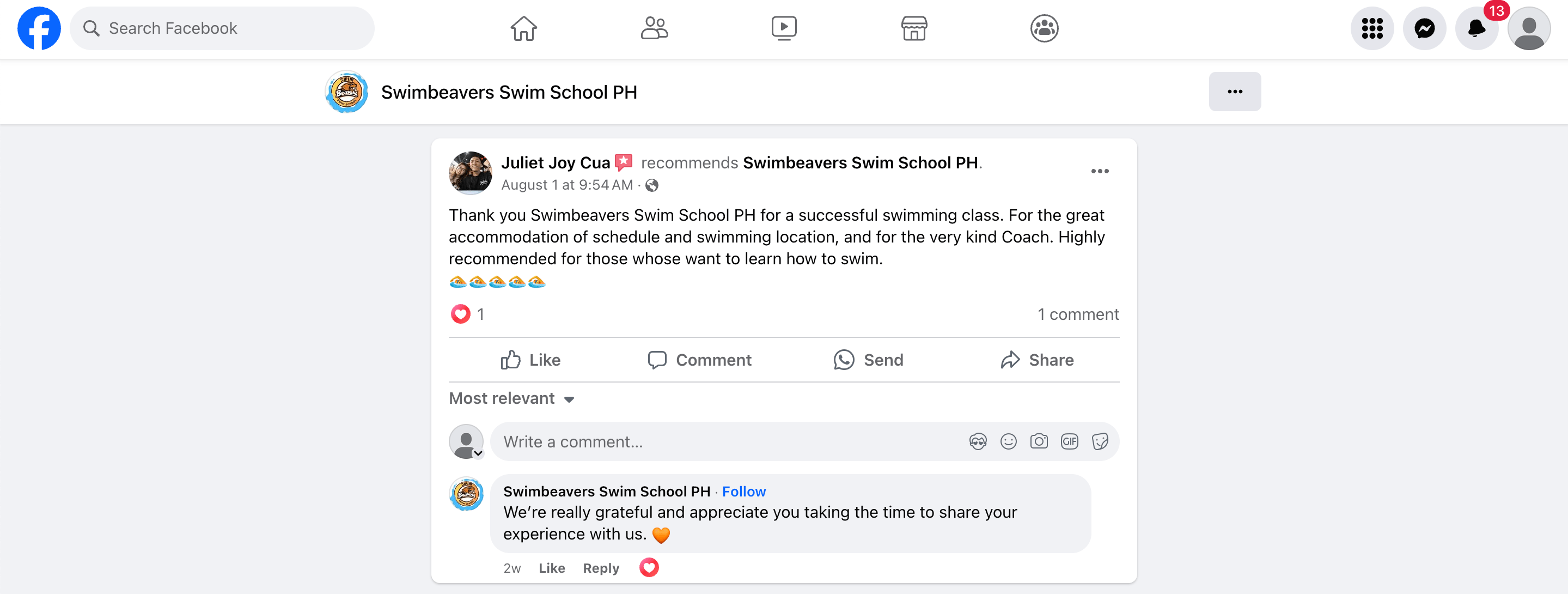
By the way, Facebook reviews are considered so trustworthy that search engines like Bing include them directly in their map results.
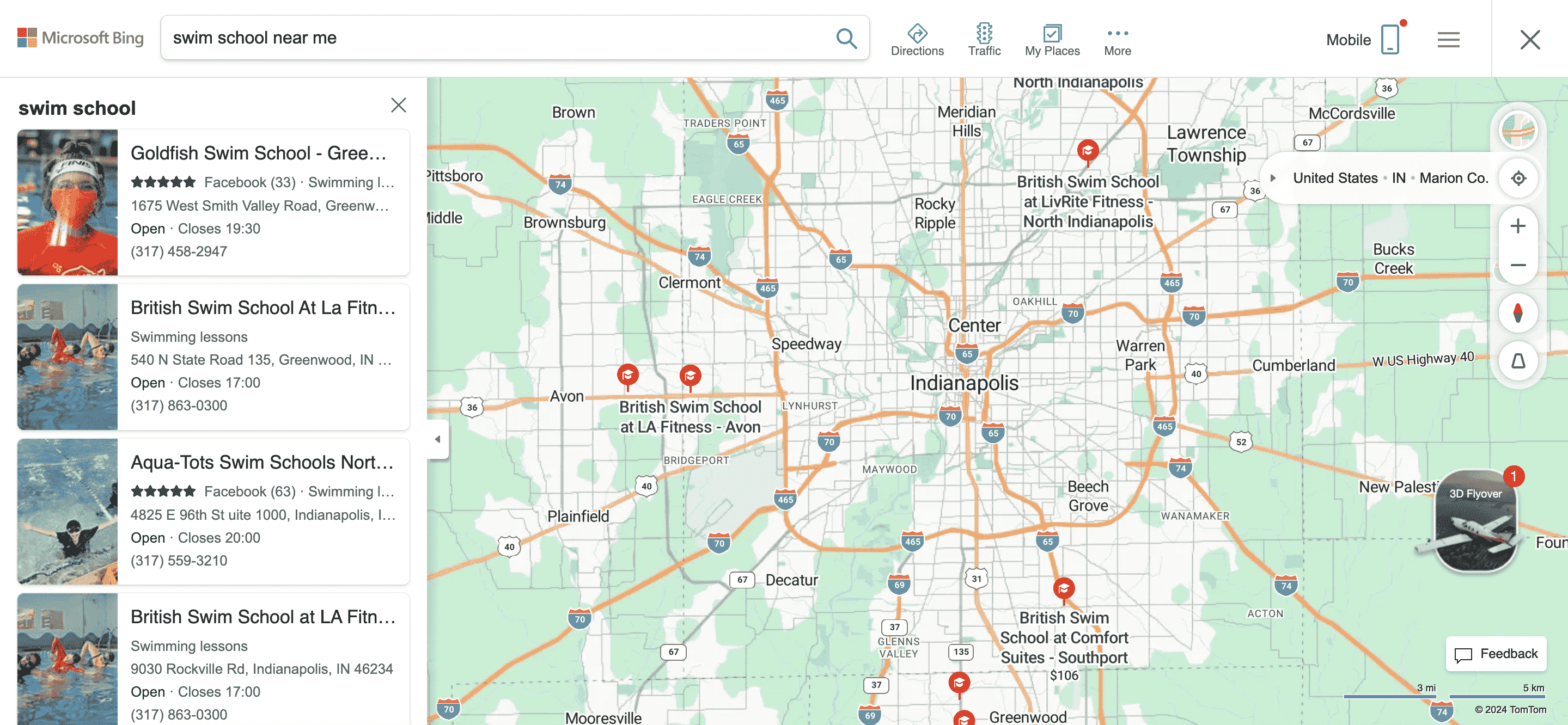
Still, it’s worth mentioning that the platform has undergone significant changes in recent years. Many users notice that its recommendation section has become increasingly cluttered with spammy results. As a result, the impact of Facebook recommendations on a business’s reputation may not be as substantial as it once was.
Despite this, Facebook remains a valuable tool for businesses. Collaborating with influencers and using paid advertising can still generate significant buzz and customer trust.
Yelp
With over 80 million people visiting Yelp each month, this platform should definitely be a priority for your business. This is especially true for small businesses, where reviews from people significantly impact customer acquisition and retention.

It’s no surprise that Yahoo and Bind feature Yelp reviews within their map results.
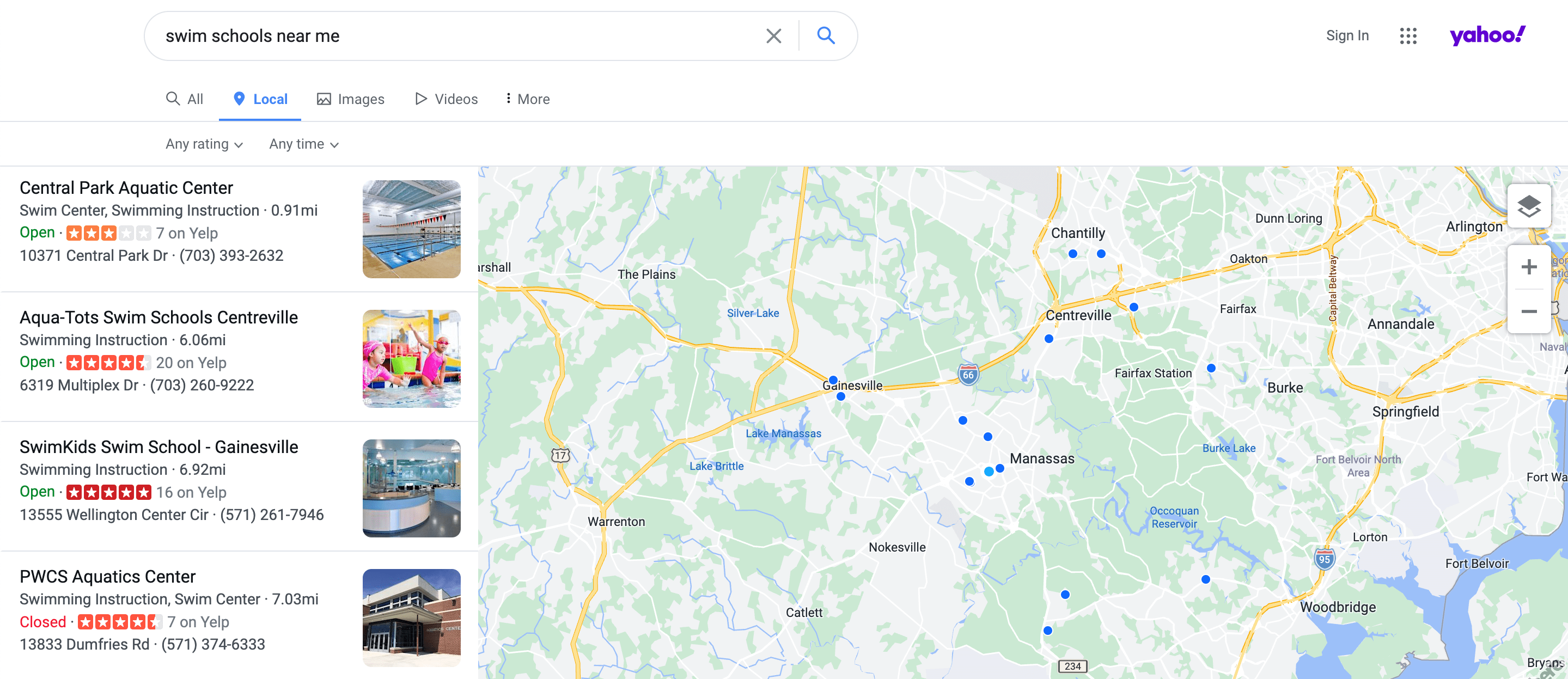
So, it doesn’t matter which local business you run (be it a retail store, restaurant, pet shop, or something else). Having a strong Yelp page can help you attract more local clients within your industry and, as a result, grow your business.
Foursquare
As a location-based platform, Foursquare also allows businesses to manage their presence in local search. One of its key features is the ability for users to leave reviews about businesses, restaurants, and various points of interest. This rich content provides a comprehensive picture of a particular business (and, therefore, allows potential customers to get a sense of what to expect).
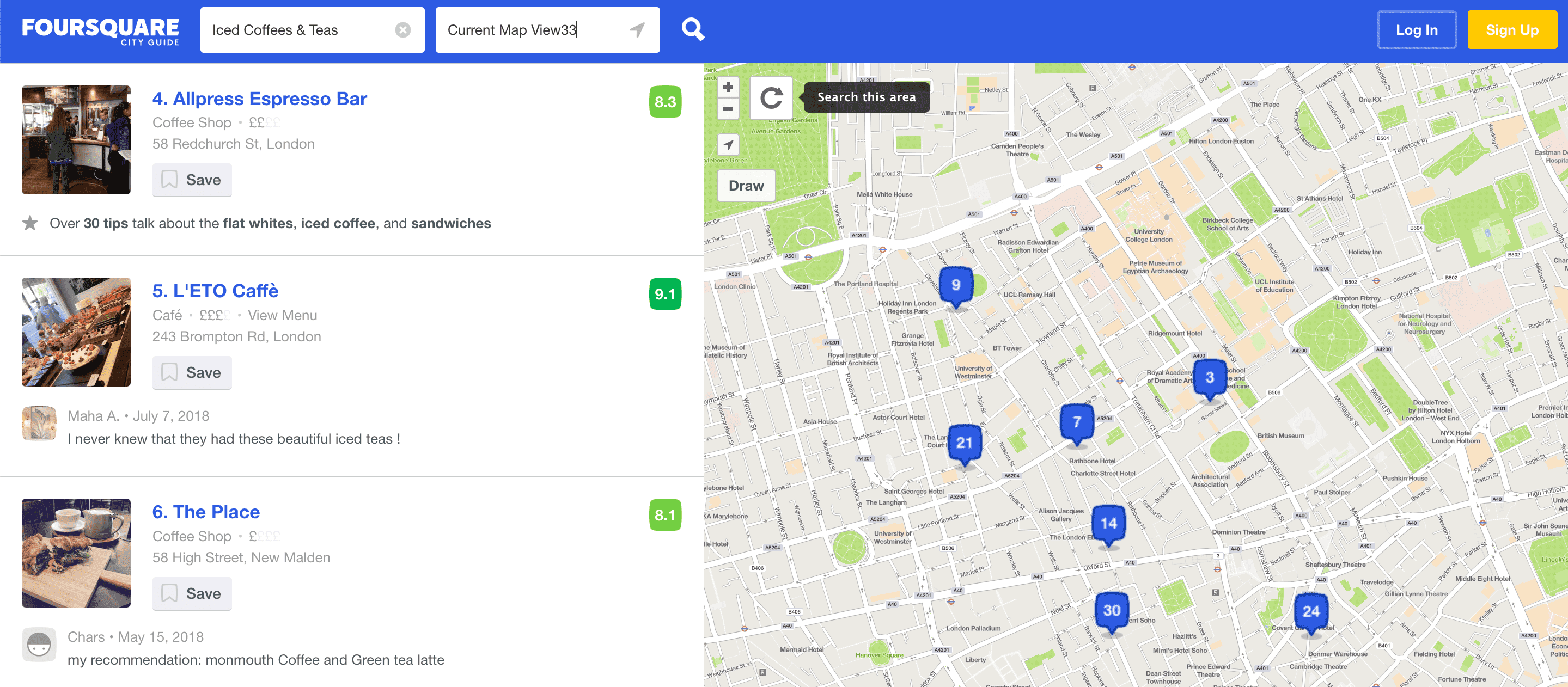
At the same time, 34% of users turn to Instagram for reviews. Additionally, 23% of individuals check TikTok for business information and reviews. This means that local businesses should also keep an eye on other review platforms to stay on top of customer reviews.
Strategies to encourage customers to leave reviews
Growing your local business’s review count doesn’t require complicated tactics. Forget about fake reviews; authentic feedback is key. Here’s the list of best practices for increasing the number of reviews you receive (without the involvement of any black hat tactics like review gating):
Directly ask your customers
Sometimes the most obvious solutions turn out to be the most effective. So, why not directly ask customers for their feedback and insights?
Face-to-face interactions provide a personal touch and can be very effective. After providing your service or completing a sale, ask customers if they would be willing to leave feedback. This review strategy can be particularly effective in service-oriented businesses where personal interaction is on a high level.
Use email and text messages to follow up with customers after their purchase or service experience. Craft a polite and personalized message thanking them for their purchase/appointment/subscription and kindly requesting a review. Email marketing platforms like ActiveCampaign and Moosend can automate and simplify the process of reaching out to local customers regularly.
The screenshot below shows a follow-up email sent to subscribers, requesting them to share their overall experience with Planoly (a social media planning and management tool) throughout the year.
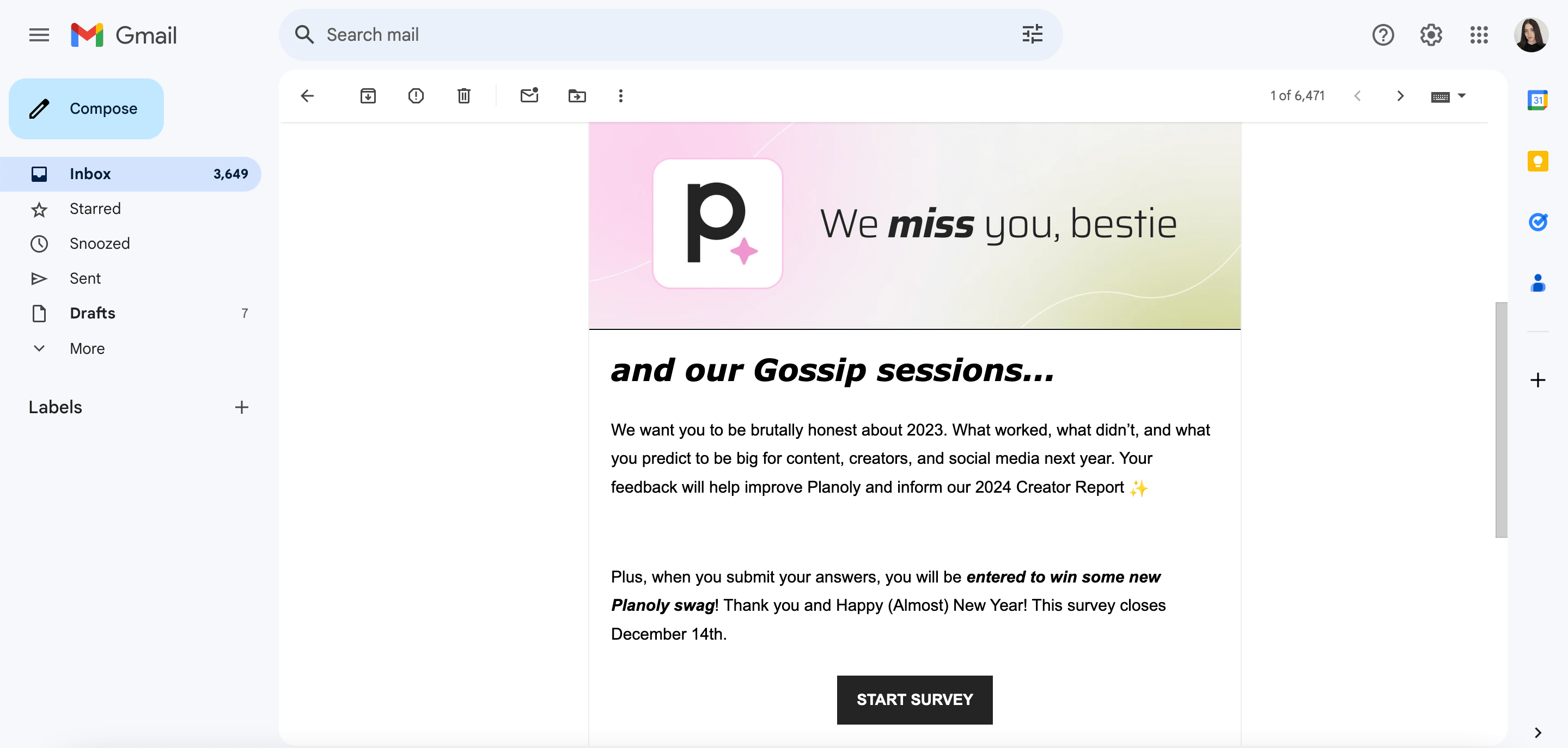
Include a request for a review on your receipts or invoices. A simple note or QR code that directs customers to your review platform can serve as a gentle reminder.
Integrate post-purchase surveys into your website or send them via email. These surveys can collect feedback and include a prompt to leave a review, capturing customers while their experience is still fresh.
If your business has a physical location where you serve clients, consider placing review kiosks near the checkout area or customer service desk. This way, customers would be able to leave their reviews there.
Optimize your website for review submissions
Local businesses can boost feedback collection by making their websites more review-friendly. This simple strategy encourages customers to leave reviews more easily.
Place clear and visible call to action (CTA) on your website, directing customers to where they can leave reviews. These CTAs should be positioned on high-traffic pages, such as your homepage, post-purchase confirmation pages, as well as service pages.
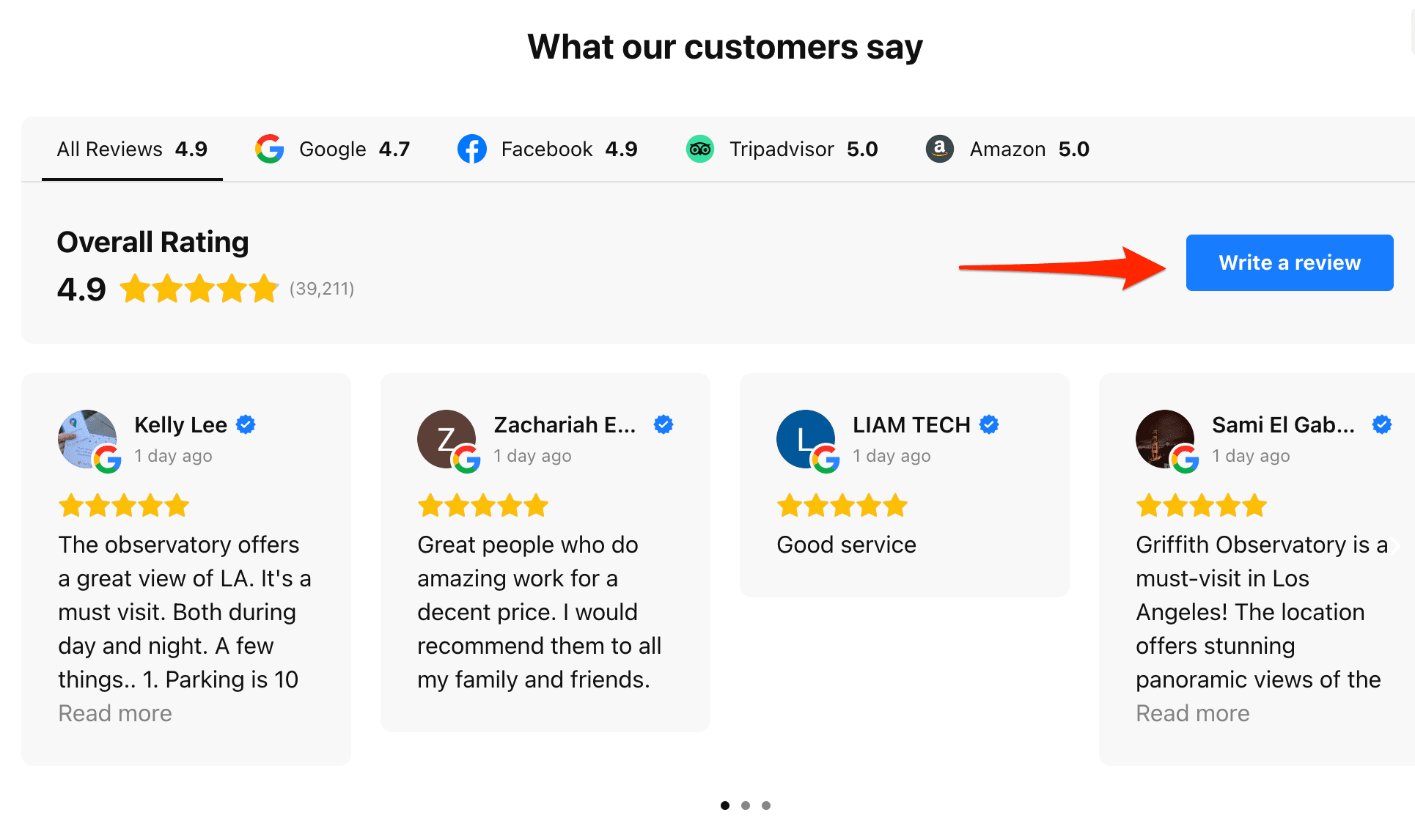
Integrate review widgets on your website that display recent reviews. This not only provides social proof but also encourages other visitors to contribute their feedback.
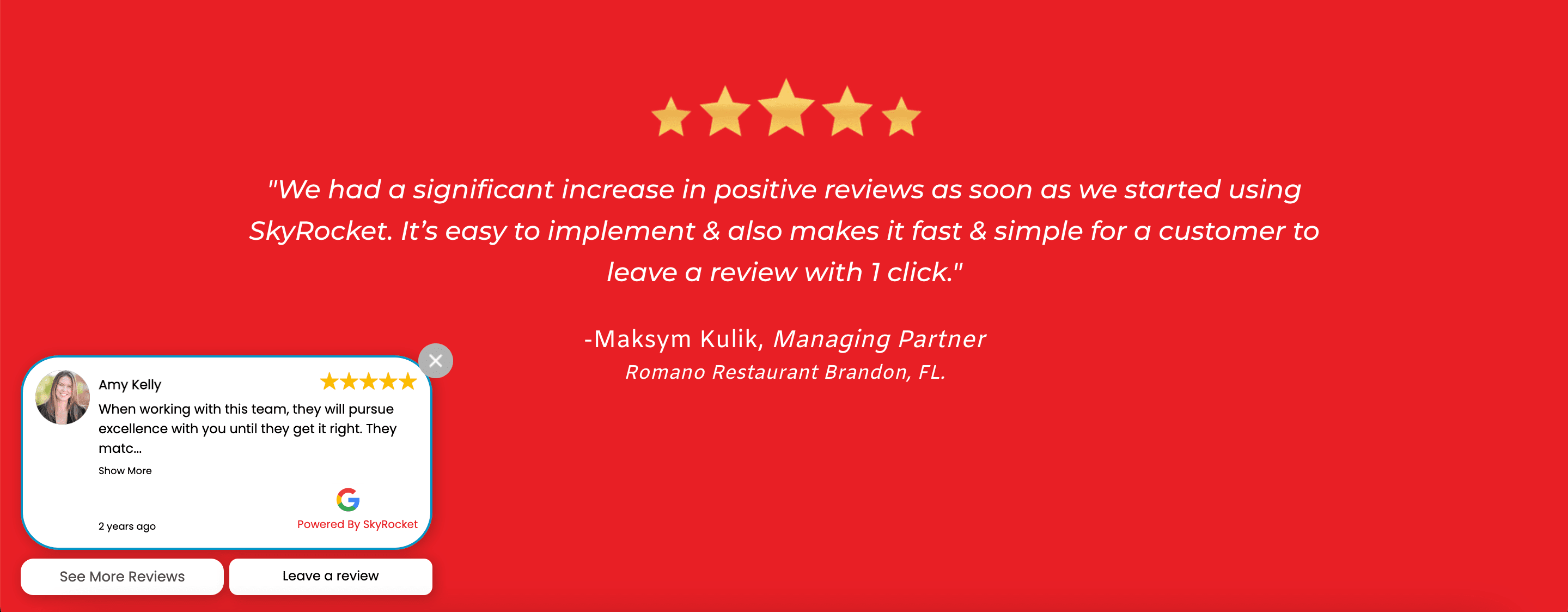
Create a dedicated page on your website specifically for showcasing reviews. This page should be easy to navigate and highlight positive feedback to encourage more customers to leave their own reviews.
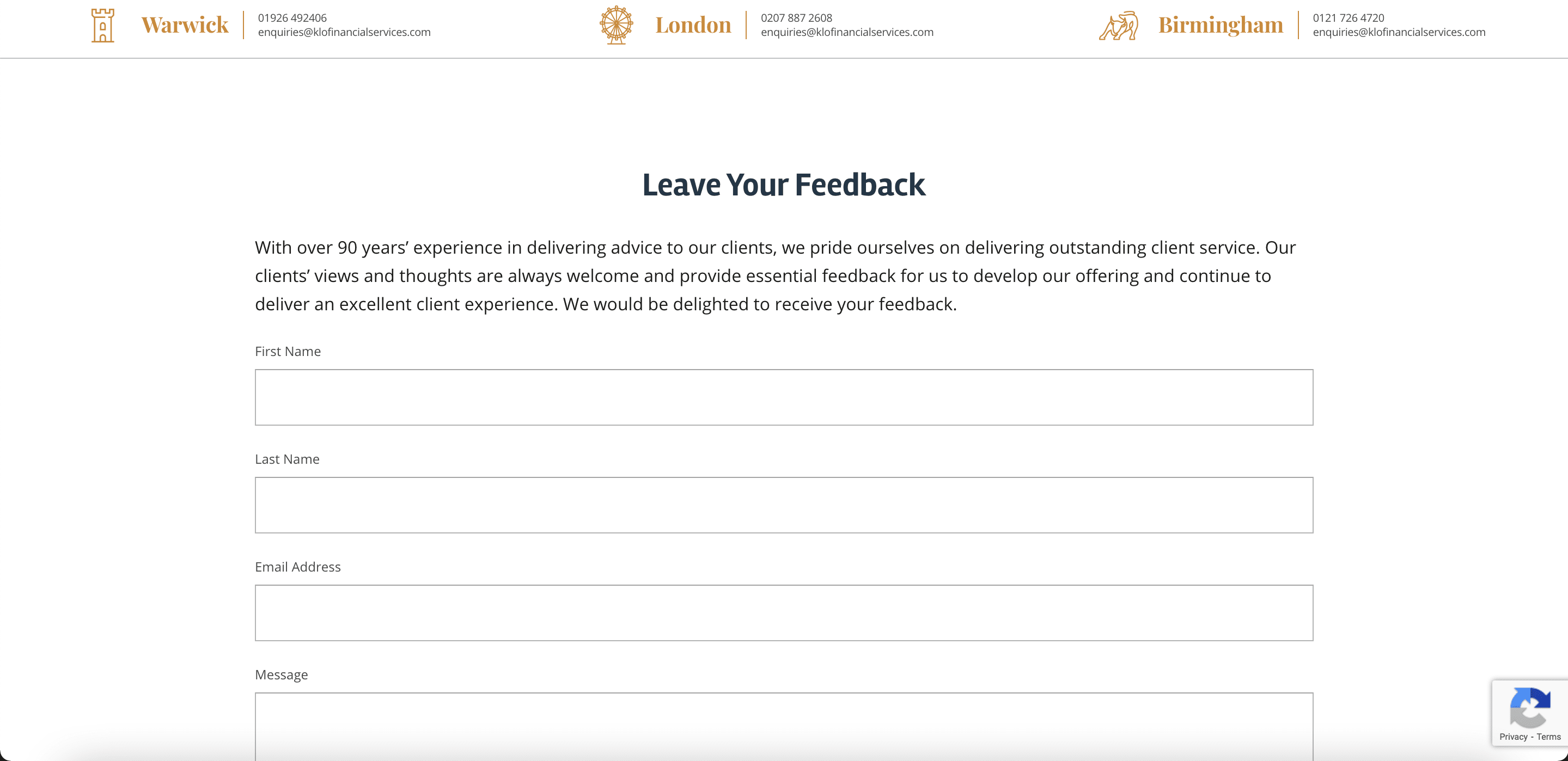
- Streamlined review forms.
Ensure that the review submission forms on your website are easy to fill out. Avoid long, complicated forms that might deter customers from leaving feedback.
Since 60% of websites traffic comes from mobile devices, it’s important to ensure your review submission process is mobile-friendly. This includes having a responsive design and easy-to-use review forms on mobile devices.
Create a review incentive program (ethically)
Offering incentives can motivate customers to leave reviews and can be an effective way to increase your review count.
Note: In the United States, the FTC explicitly prohibits offering incentives in exchange for positive or negative reviews. Incentives can be offered, but they must not be conditioned a particular sentiment.
- Loyalty rewards programs.
Implement a rewards program where customers earn points or receive discounts for leaving reviews. This can encourage more customers to participate and can also boost customer loyalty.
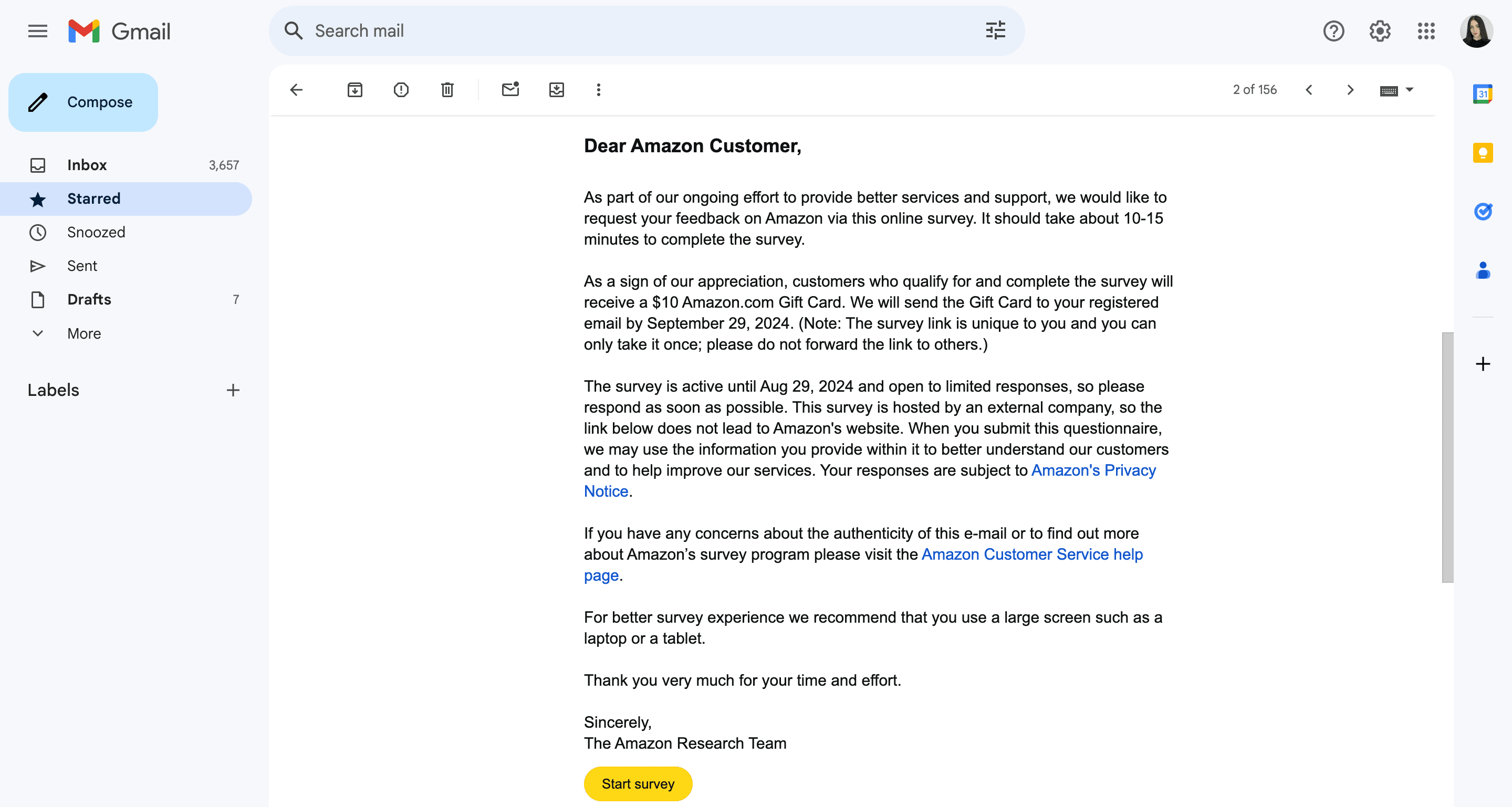
Host contests or giveaways where customers can enter by leaving a review. The chance to win a prize can increase the number of reviews you receive and generate excitement around your brand.
Offer rewards for customers who refer friends and write reviews. This can expand your customer base while simultaneously increasing the number of reviews.
Provide exclusive offers or early access to new products or services for customers who leave a review. This can be an effective way to incentivize feedback while also driving engagement.
Use social media to collect reviews
Today, social media platforms are no longer simple networking platforms. They are powerful tools for gathering reviews and enhancing your business’s online presence.
Regularly ask your social media followers to share their experiences and leave reviews. Create posts or stories that encourage feedback and make it easy for followers to leave a review.
- Highlight positive feedback.
Share positive reviews and customer success stories on your social media channels. This not only showcases your positive reputation but also encourages others to leave their own feedback.
Engage with your audience by responding to comments and messages promptly. This shows that you value customer input and can motivate others to share their experiences.
Build relationships with the community
Developing a strong community presence within your local market can organically lead to more reviews and foster a positive brand image.
Partner with other local businesses for cross-promotion. This can introduce you to new customer segments and generate more reviews through mutual recommendations. For example, a yoga studio could partner with a healthy food cafe to offer discounted packages for both services.
Actively participate in local events, sponsor community activities, or support local charities. Your involvement can build trust and goodwill, leading to positive reviews from community members.
Engage with local media or bloggers to feature your business. Positive ratings and reviews from local influencers can drive more customers to share their own feedback.
Simplify the review submission process
An easy and straightforward review process is crucial for maximizing feedback collection on your website.
Provide clear, concise instructions on how to leave a review. This can include step-by-step guides or tooltips to assist customers throughout the process.
Reduce the number of steps required to leave a review. Streamline the process to make it as quick and effortless as possible for customers.
Ensure that your review submission platforms are easy to navigate. A clean and intuitive design will reduce friction and encourage more customers to leave feedback.
Use visual aids such as infographics or short videos to guide customers through the review process. This can help clarify any confusion and ensure a smooth submission experience.
Set up automated reminders to prompt customers to leave a review after their purchase or service experience. This can help keep the review request top of mind and increase response rates.
Responding to online reviews effectively
Interacting with your reviews is as crucial as collecting them. In fact, a significant majority (88%) of consumers are likely to patronize a business that responds to all reviews, while only half (47%) would consider a business that ignores them. Pretty impressive number, isn’t it?
That being said, engaging with every review—positive or negative—demonstrates that you’re attentive and value your customers’ opinions. This not only enhances your relationship with existing clients but can also impact the perception of your business among prospective customers.
Best practices for responding to positive reviews
1. Express gratitude.
When responding to good reviews, start by sincerely thanking the customer for their kind words. This simple act of acknowledgment can make customers feel valued and appreciated, which can encourage them to return and continue supporting your business.
Example: “Thank you so much for your feedback! We’re thrilled to hear you had a fantastic experience.”
2. Personalize your response.
A tailored response demonstrates your attention to detail and strengthens the customer relationship. So, show customers you’ve read their review by referencing specific details about their experience. This personalized touch makes customers feel heard and valued.
Example: “We’re delighted you loved our new lavender-infused tea, [customer’s name]! It’s wonderful to hear it brought a smile to your day.”
3. Invite further engagement.
Encourage customers to continue their relationship with your business by suggesting they try new products or services, join your loyalty program, or follow your social media channels. This invites deeper engagement and increases the likelihood of repeat business.
Example: “We’re so glad you enjoyed your stay! Have you tried our spa services yet? We think you’ll **** them.”
4. Maintain a professional tone.
While enthusiasm is encouraged, it’s crucial to maintain a professional tone in your responses. Avoid overly casual language or excessive exclamation points. A professional tone reflects positively on your business and reinforces your commitment to providing excellent customer service.
Example: “We appreciate your kind feedback. Your satisfaction is our top priority, and we’re happy to hear we met your expectations.” (Instead of: “OMG, we’re so stoked you loved it!”)
5. Respond timely.
Responding promptly to positive reviews keeps the dialogue fresh and reinforces the customer’s positive experience. Aim to reply within 24-48 hours of the review being posted.
Tips for handling negative reviews
1. Acknowledge the issue.
The first step in addressing a low-star review is to acknowledge the customer’s concerns. Validate their feelings by expressing empathy and understanding. This demonstrates that you take their feedback seriously and are committed to finding a resolution.
Example: “We’re sorry to hear about your disappointing experience. Your feedback is important to us.”
2. Offer a sincere apology.
A genuine apology can go a long way in diffusing a negative situation. Express regret for the customer’s negative experience and assure them you will take steps to prevent it from happening again. This shows you care about their satisfaction and are committed to making things right.
Example: “We apologize for the inconvenience caused by the late delivery. We understand how frustrating that must have been.”
3. Propose solutions.
Once you’ve acknowledged the issue and apologized, offer a specific solution to resolve the problem. This could involve a refund, replacement, or discount. Be clear and concise about the steps you will take to address the customer’s concerns.
Example: “To make things right, we’d like to offer you a 20% discount on your next order. Please contact our customer support team to redeem it.”
4. Take the conversation offline.
In some cases, it’s best to address negative reviews privately. Offer to contact the customer directly to discuss the issue further. This allows you to gather more information, find a suitable solution, and avoid a public back-and-forth.
Example: “We’d like to address your concerns directly. Please provide us with your contact information, or feel free to contact us at [phone number] or [email address].
5. Respond publicly.
Addressing negative reviews publicly can build trust with potential customers. It shows that you’re willing to engage with feedback and are committed to high standards. Ensure your response is respectful and solution-focused to maintain a positive public image.
Example: “Thank you for bringing this to our attention. We’ve reached out to [customer’s name] to resolve the issue and prevent this from happening again.”
6. Learn from feedback.
Use negative reviews from customers as an opportunity to improve. Analyze recurring issues and make necessary changes to enhance your products or services. This proactive approach can turn a negative experience into a positive outcome for your business.
Conclusion
Local business reviews undeniably hold the power to shape your business’s journey. Actively collecting and responding to reviews on platforms like Yelp, Facebook, and GBP can elevate your online presence and build long-lasting customer trust. Implement these practical strategies to create a thriving ecosystem of satisfied customers who vouch for your business and attract more local business clients through their authentic feedback.
Remember, in the world of local business, it’s your customers’ voices that can turn the tide. Listen closely, engage actively, and watch your business flourish.
